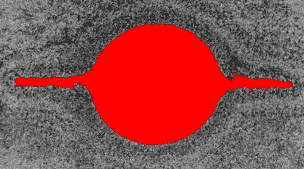|
You're
at
Borehole Breakouts
Experimental Studies of Anisotropy on Borehole Breakouts in Mancos Shale
Fracture-like
Borehole Breakouts in Highly Porous Sandstone:Are they Caused
by Compaction Bands?
Simulation
of Borehole Failure Phenomena using Discrete Element Modeling
Fracture
Permeability and In Situ Stress in the Dixie Valley, Nevada,
Geothermal Reservoir
Fracture-like
Borehole Breakouts in Highly Porous Sandstone:Are they Caused
by Compaction Bands?

|
Extensive field evidence and laboratory experiments
suggest that borehole  breakouts,
defined as borehole cross-section elongations resulting from
preferential rock failure, is a direct consequence of the
in situ stress in the rock. One of the early observations
of breakouts was in the quartzite and conglomerates of the
Witwatersrand gold mine in South Africa (Leeman, 1964). The
spalling was observed to occur at diametrically opposed points
on the borehole wall perpendicular to the direction of the
maximum principal stress. breakouts,
defined as borehole cross-section elongations resulting from
preferential rock failure, is a direct consequence of the
in situ stress in the rock. One of the early observations
of breakouts was in the quartzite and conglomerates of the
Witwatersrand gold mine in South Africa (Leeman, 1964). The
spalling was observed to occur at diametrically opposed points
on the borehole wall perpendicular to the direction of the
maximum principal stress.
The most publicized observation of breakouts
was in the 3 m diameter drift at 420 m level in the Underground
Research Laboratory (URL), Canada. Two diametrically opposed
breakouts were approximately aligned with the vertical stress,
which is the overall least principal stress at URL.
The breakout phenomena was also observed in
the non-welded Paint Brush tuff along the spring line of the
Exploratory Studies Facility approximately 250 m below the
Yucca Crest, Nevada. The measured stress regime reveals that
both horizontal stresses are smaller than the vertical stress,
suggesting the overall maximum principal stress is the vertical
stress.
Three different modes of failure have been suggested
as the mechanism leading to the breakout.
Extensile failure model
(V. Maury, 1987; Haimson and Herrick, 1986; Lee and Haimson,
1993; Song and Haimson, 1997)
A family of subparallel microcracks was induced
without any obvious shear displacement behind the borehole
wall in the two zones aligned with the minimum horizontal
stress direction. The cracks are densely spaced and subparallel
both to the borehole wall and the maximum horizontal stress
direction. Progressive spalling of detached flakes bounded
by these extensile cracks leads to deep and pointed breakouts.
Shear failure model
(Zoback et. al, 1985)
Cracks initiates at the borehole wall, were
intergranular and propagated along a pth of high shear stress.
Moreover breakouts were formed by the intersection of two
distinct conjugate fractures, rather than by clusters of flakes
between micorcracks.
Compaction band model
(B.C. Haimson, in Phys. Chem. Earth(A), Vol. 26, no.1-2, pp.
15-20, 2001)
 In
high porosity granular rock, breakouts initiate at the borehole
wall in the two zones aligned with the minimum horizontal
stress direction. In previous models, propagation of breakouts
was limited by the diminishing length of the flakes (extensile
failure model) or by the domain defined by crossing conjugate
fractures. However, in highly porous (approximately 20 to
25% or more) rock, initiation of breakouts provides seed for
the propagation of anti-mode I fracture in the form of compaction
band. The tip of the breakout or anti-mode I fracture advances
orthogonally to the maximum horizontal stress. The typical
shape of the breakouts created under this condition is in
the form of long fracture with compaction band ahead of the
fracture tip. In
high porosity granular rock, breakouts initiate at the borehole
wall in the two zones aligned with the minimum horizontal
stress direction. In previous models, propagation of breakouts
was limited by the diminishing length of the flakes (extensile
failure model) or by the domain defined by crossing conjugate
fractures. However, in highly porous (approximately 20 to
25% or more) rock, initiation of breakouts provides seed for
the propagation of anti-mode I fracture in the form of compaction
band. The tip of the breakout or anti-mode I fracture advances
orthogonally to the maximum horizontal stress. The typical
shape of the breakouts created under this condition is in
the form of long fracture with compaction band ahead of the
fracture tip.
|
|
|
|
Bell,
J.S and D.I. Gough, Northeast-southwest compressive
stress in Alberta:evidence from oil wells, Earth Planet
Sci. Let. 45, 475-482, 1979.
Haimson,
B. C. and C. Herrick, Borehole breakouts-a new tool
for estimating in situ stress? in rock stress, Ed. O.
Stephansson, CENTEK Publishers, Lulea, Sweden, pp. 271-280,
1986.
Haimson,
B. C. and I. Song, Laboratory study of borehole breakouts
in Cordova Cream: a case of shear failure mechanism,
Intl. J. Rock Mech. and Mining Sci., 30, 1047-1056,
1993.
Lee
M. Y. and B. C. Haimson, Borehole Breakouts in Lac du
Bonnet Granite: A Case of Extensile Failure Mechanism,
Int. J. Rock Mech. Min. Sci. & Geomech. Abstr. 1539-1545,
1993.
Zoback,
M.D., D. Moos, L. Mastin, and R.N. Anderson. Wellbore
breakouts and in-situ stress. J. Geophys. Res., 90,
5523-5530.
|
|